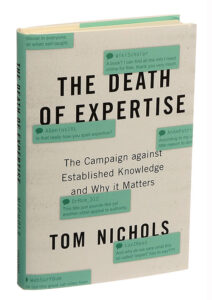If you’re a professor or graduate student, you know more about your field of study than most of the writers filling opinion pages, Twitter feeds, and bookshelves right now. Your research informs your point of view. You know what you’re talking about — but pundits know how to write for the general public.
 This means that the voices who have the most to contribute to public discourse are often getting drowned out. In his 2014 article “The Death of Expertise” (later turned into a book), Tom Nichols laments the “Google-fueled, Wikipedia-based, blog-sodden collapse of any division between professionals and laymen, students and teachers, knowers and wonderers — in other words, between those of any achievement in an area and those with none at all.”
This means that the voices who have the most to contribute to public discourse are often getting drowned out. In his 2014 article “The Death of Expertise” (later turned into a book), Tom Nichols laments the “Google-fueled, Wikipedia-based, blog-sodden collapse of any division between professionals and laymen, students and teachers, knowers and wonderers — in other words, between those of any achievement in an area and those with none at all.”
I don’t mean to belittle non-academic voices; I’m not an academic either. But having spent the last decade in communications and publishing, I believe scholars need to be able to share their knowledge easily with the rest of us — and that means being able to write for a popular audience.
If this is something you struggle with, here are five writing tips:
1. Spend time on your opening.
Don’t treat your first paragraph like it’s the warm-up before you get to the good stuff. Treat it like your only opportunity to pull the reader in. Your lede is your promise to your reader: You’re promising that your words are worth their time. If you have writer’s block, look at the opening paragraphs of a practiced columnist — someone like David Brooks at The New York Times or George Will at The Washington Post — to see how they successfully hook readers.
2. Keep it lean.
Make your points in as few words as possible. You’re not giving a lecture to a captive audience; you’re trying to connect with a busy reader. You don’t need to satisfy a critical peer review by including all relevant literature and every possible supporting point. “A sentence should contain no unnecessary words, a paragraph no unnecessary sentences,” Strunk and White advise in The Elements of Style. Eliminate anything that doesn’t give your reader recognizable value. And cut phrases that create clutter, such as It could be said that… or It is important to note that... If it weren’t important, you wouldn’t be noting it.
3. Think: Would a reader be compelled to share this after reading it?
 Whether or not you value social media, you should think about social media as an essential piece of 21st-century opinion-writing. The pieces that drive conversations, change the way people think, and delight media outlets by generating traffic are the ones that are shared widely on social channels. Put yourself in your reader’s position: Why would they share your piece with friends? What new information or new way of thinking are you introducing? What great story, fact, or quote from your piece would a reader paste into Twitter, Facebook or LinkedIn? If you have trouble imagining a flurry of people sharing and commenting on your piece online, you’re not done writing it. That doesn’t mean you should cater to readers’ worst impulses and turn a thoughtful piece into outrage-bait; it means giving thoughtful readers a compelling reason to share your words.
Whether or not you value social media, you should think about social media as an essential piece of 21st-century opinion-writing. The pieces that drive conversations, change the way people think, and delight media outlets by generating traffic are the ones that are shared widely on social channels. Put yourself in your reader’s position: Why would they share your piece with friends? What new information or new way of thinking are you introducing? What great story, fact, or quote from your piece would a reader paste into Twitter, Facebook or LinkedIn? If you have trouble imagining a flurry of people sharing and commenting on your piece online, you’re not done writing it. That doesn’t mean you should cater to readers’ worst impulses and turn a thoughtful piece into outrage-bait; it means giving thoughtful readers a compelling reason to share your words.
4. Use short sentences and paragraphs.
You’re vying for your reader’s time when they could be doing a thousand other things. The opportunity cost of reading your piece is doing anything else on the internet. If reading your piece feels like work, most people will quickly opt-out. Treat readers’ time with respect by making the reading experience easy. Don’t write block-paragraphs that an eye gets lost in. Don’t write winding sentences that a person has to re-read to understand.
5. Be willing to rework your language and framing.
 If the way you talk about your field of study isn’t resonating with popular audiences, rethink how to translate your enthusiasm and knowledge. What’s compelling to you isn’t necessarily compelling to a popular audience. Let go of language, framing, and tropes that fail to engage readers, even if they work in an academic setting. You’re trying to market your knowledge for mass audiences, and marketing is a trial and error process. “Kill your darlings” is a phrase usually attributed to William Faulkner, but I prefer Stephen King’s version in On Writing: “Kill your darlings, kill your darlings, even when it breaks your egocentric little scribbler’s heart, kill your darlings.”
If the way you talk about your field of study isn’t resonating with popular audiences, rethink how to translate your enthusiasm and knowledge. What’s compelling to you isn’t necessarily compelling to a popular audience. Let go of language, framing, and tropes that fail to engage readers, even if they work in an academic setting. You’re trying to market your knowledge for mass audiences, and marketing is a trial and error process. “Kill your darlings” is a phrase usually attributed to William Faulkner, but I prefer Stephen King’s version in On Writing: “Kill your darlings, kill your darlings, even when it breaks your egocentric little scribbler’s heart, kill your darlings.”
Here are some other writing resources that might help:
“Writing Effective Op-eds” by Duke University
“How to Start Writing for the Public” by Victor Ray, Inside Higher Ed
“You Want to Write for the Public, But About What?” By Katie Rose Guest Pryal, The Chronicle of Higher Education
The Elements of Style by William Strunk and E.B. White
Dreyer’s English by Benjamin Dreyer
